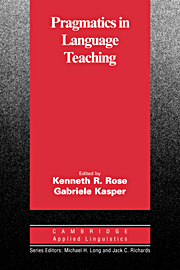Book contents
- Frontmatter
- Contents
- List of contributors
- Series editors' preface
- Preface
- Chapter 1 Pragmatics in language teaching
- I THEORETICAL AND EMPIRICAL BACKGROUND
- II ISSUES IN CLASSROOM-BASED LEARNING OF PRAGMATICS
- III THE EFFECTS OF INSTRUCTION IN PRAGMATICS
- Chapter 7 Acquiring French interactional norms through instruction
- Chapter 8 Inductive and deductive teaching of compliments and compliment responses
- Chapter 9 The role of input enhancement in developing pragmatic competence
- Chapter 10 Explicit and implicit teaching of pragmatic routines: Japanese sumimasen
- Chapter 11 Explicit instruction and JFL learner's use of interactional discourse markers
- IV THE ASSESSMENT OF PRAGMATIC ABILITY
- References
- Name index
- Subject index
Chapter 11 - Explicit instruction and JFL learner's use of interactional discourse markers
Published online by Cambridge University Press: 05 October 2012
- Frontmatter
- Contents
- List of contributors
- Series editors' preface
- Preface
- Chapter 1 Pragmatics in language teaching
- I THEORETICAL AND EMPIRICAL BACKGROUND
- II ISSUES IN CLASSROOM-BASED LEARNING OF PRAGMATICS
- III THE EFFECTS OF INSTRUCTION IN PRAGMATICS
- Chapter 7 Acquiring French interactional norms through instruction
- Chapter 8 Inductive and deductive teaching of compliments and compliment responses
- Chapter 9 The role of input enhancement in developing pragmatic competence
- Chapter 10 Explicit and implicit teaching of pragmatic routines: Japanese sumimasen
- Chapter 11 Explicit instruction and JFL learner's use of interactional discourse markers
- IV THE ASSESSMENT OF PRAGMATIC ABILITY
- References
- Name index
- Subject index
Summary
Introduction
The development of L2 pragmatic competence entails the ability to use a wide range of conversational routines and discourse strategies to manage one's communicative interactions with others. Since the early 1980s, researchers have established that a foreign language learner's development of various aspects of pragmatic competence may be facilitated by the instruction of pragmatic routines and strategies in the foreign language classroom (Kasper, this volume). House (1996, p. 247) points out that when such instruction is explicit, it appears to be particularly beneficial since it enables learners to develop an awareness and understanding of the differences between L1 and L2 pragmatic preferences, and thereby “counteract negative L1 transfer through ‘noticing’ (Schmidt, 1993b) and through making attempts to use alternative, more L2 norm-oriented expressions.” In a comparison of the relative benefits of implicit and explicit instruction, House (1996) reports on two sections (i.e., implicit and explicit) of a 14-week communication course instructed in the use of everyday, conversational routines. Through lectures, handouts, and explanatory feedback that provided metapragmatic information on the use and function of these routines, the members of the explicit group had additional opportunities to raise their awareness of preferred L2 pragmatic practices and to “notice” differences between L1 and L2 practices. House argues that the greater improvement shown by the explicit group, particularly in areas where the pragmatic preferences of the learners' L1 differed from those of the target L2, is a result of the learners' heightened awareness of L1-L2 pragmatic differences.
- Type
- Chapter
- Information
- Pragmatics in Language Teaching , pp. 223 - 244Publisher: Cambridge University PressPrint publication year: 2001
- 41
- Cited by



